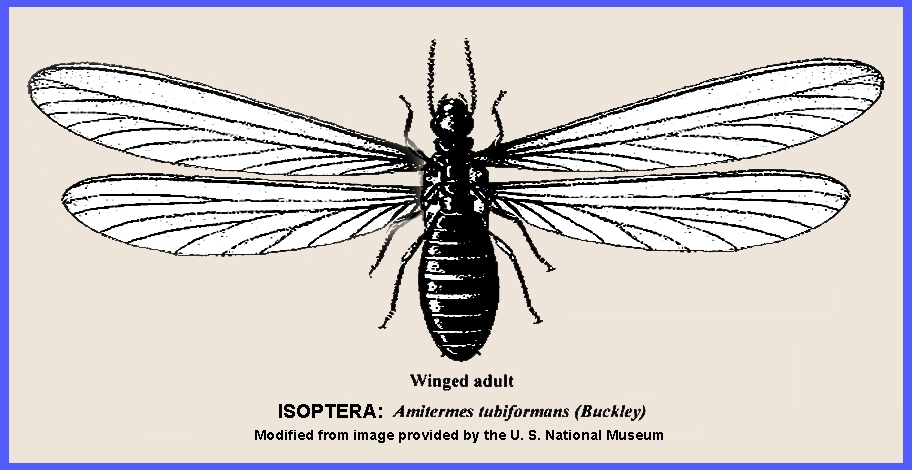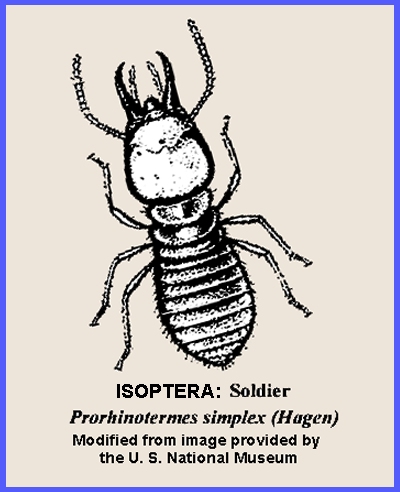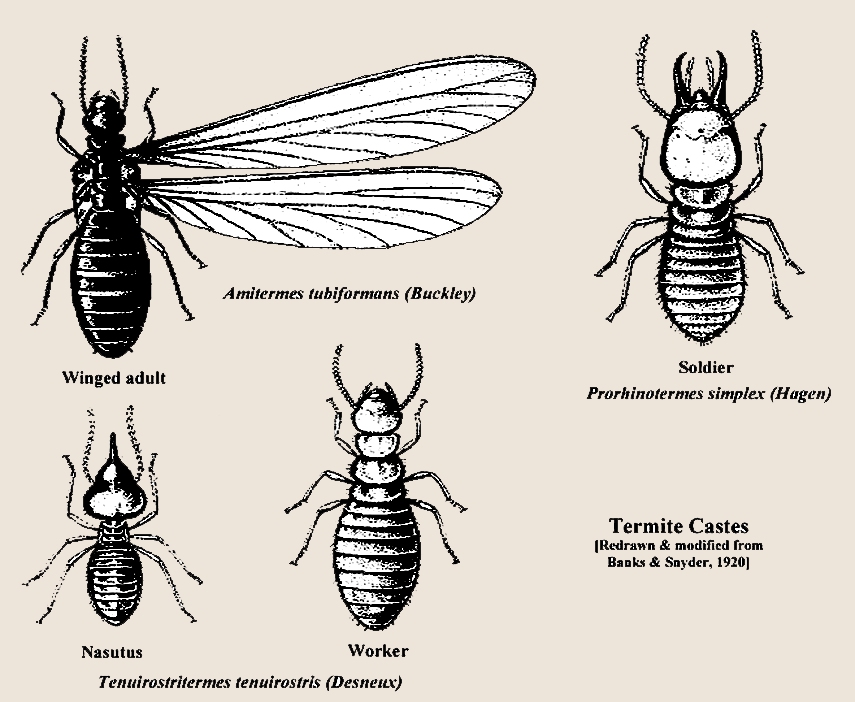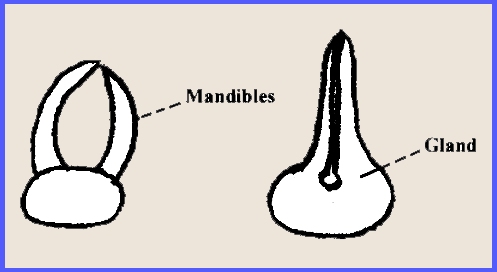File:
<isoptera.htm> < (Entomology),
(Invertebrates), (General
Index)> <Invertebrate Bibliography> <Glossary> <Site Description>
< Home>
|
Entomology: ISOPTERA 1 Kingdom: Animalia, Phylum: Arthropoda Subphylum: Hexapoda: Class: Insecta: Order: Isoptera (Contact) Please CLICK on underlined
categories to view and on included illustrations to enlarge: Depress Ctrl/F
to search for subject matter:
Isoptera, which means
"equal-wings," are social and polymorphic insects with biting
mouthparts, four-lobed ligula, wings that are very similar elongated and
membranous and capable of being broken off along a line at the base. Their cerci are short. Metamorphosis is simple. They, like some Hymenoptera, have a social
organization. Termites abound
everywhere in the tropics where they cause extensive damage to wood products. The
termite nests may be simply series of burrows in trees, dry timber or in the ground,
or they may be huge mounds made of earth cemented together with the saliva of
the termites. Those living in the ground excavate the soil of the tropics,
turning it over and enriching it just as earthworms do in temperate regions.
Others may remove permanently from the soil much of its organic matter. Their food consists mostly of wood and
other vegetable matter and many species are extremely harmful, e.g. Neotermes,
which damages human structures, and Calotermes militaris, which
bores into and does much harm to tea plants in Ceylon (Borradaile
& Potts, 1958). Many species of
termites reduce dead wood to organic soil material and thereby make
agriculture possible in some areas.
However, termites are in competition with humans for wood through
their damage to buildings. They are
of greatest importance in warmer regions. There are basically two types of
termites: subterranean and dry
wood. Subterranean termites are soft
bodied with a thin cuticle. They
obtain moisture from the soil or metabolic processes. They are more organized than the drywood
type. They also modify their habitats
by constructing tubes in their foraging activities for food. Mounds, called termitaria, are constructed in
some areas. These often reach
heights of one or two meters, and they are oriented to a north and south
direction for heating purposes. Nests
are sometimes built in trees, although these are smaller. They may contain fungus chambers. Dry wood termites confine their
nests to the wood that they depend upon for food. They are widespread and cause considerable damage to wooden
houses and the wood products contained therein (chairs, tables, etc.). Termites usually forage by night
for plant food, and members of the subfamily Microtermitinae cultivate fungus
gardens in special galleries. The fungus, which grows on a bed of
chewed vegetable matter, serves as the food for the royal pair and the
nymphs. Their principal food is
cellulose, which is digested by flagellated Protista symbionts (Zoomastigina) in their
gut. These symbionts are passed on in
two ways: (1) regurgitated liquid
food and (2) excrement. Protein is
obtained by eating dead termites. Digestion and growth of
wood-eating termites can only proceed when flagellate fauna occur in the
hindgut. The fragments of wood are ingested by the flagellates and converted
into sugars, being for the most part stored in the form of glycogen. The
termite requires the metabolic services of the flagellates to render the food
available, and in return provides the anaerobic conditions that the
flagellates are known to require.
The mandibles and head of worker
termites are modified to produce enlarged forceps-like mandibles,
snout-shaped structures and plug-shaped structures. Some of the more primitive termite
species have only two castes:
reproductives and soldiers.
Immature individuals of these two castes perform work in the colony. When conditions such as high
humidity, light intensity, ample food and overcrowding are present, wings are
produced and functional males and females develop. These leave the colony, and the winged sexual forms in several
colonies usually swarm at the same time, so enabling intercrossing between
members of different colonies to take place, and of the immeasurable numbers,
a few individuals escape the attacks of birds and other animals and alight
and cast their wings. The insects pair in flight and
then drop to the ground to seek a nesting site at the discretion of the
female. They lose their wings, mating
takes place and unlike other insects, the male remains with the female and
frequent mating takes place. Soon
after mating the female loses all capacity other than egg laying, and a
single pair forms a new colony first of all by making a small burrow, the nuptial chamber.
The first-formed young are mostly workers and, having themselves been
tended to maturity by their parents, take over the nursing of the young. The
queen becomes massive and helpless and is fed by the workers; she lays eggs
at an unbelievable rate of over one million eggs annually. Eliminating termites from
dwellings can be an expensive undertaking especially if they are widespread
within. Tenting and fumigating is the
usual procedure that is required by law in some areas when houses are
sold. Nevertheless, this is not a
permanent solution, as reinvasion will inevitably occur. Spot treatment of infested beams can be
achieved with pressurized aerosol insecticides available on the open
market. However, it is essential to
penetrate the entire colony. Small
blackish beadlike droppings below infested beams are indicative of their presence
somewhere above. Temperature
influences their movements in the beams:
high temperatures cause them to descend to lower, cooler levels and
low temperatures cause them to seek out warmer areas. Preventative measures can be taken
by shielding wood surfaces with metal flashings, especially where these touch
the ground, and by treating outdoor wood with preservative chemicals (e.g.,
creosote). Swarming by alate adults in the
North American Southwest occurs during late springtime. It is not uncommon to see local lizards
consuming them at a rapid rate as they emerge from their colonies. Where the feeding is very extensive it
undoubtedly has a significant impact on the termite populations. Also, the Argentine ant has been
associated with declines in termite populations in the Riverside, California
area. The ants have been observed
feeding on dieing alate termites, but other associations are yet to be
investigated to account for reductions in the structure infestations.
|





